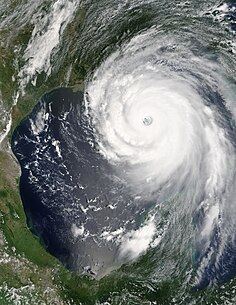| Category 5 hurricane ( SSHS) | ||
|---|---|---|
 | ||
| Formed | August 23, 2005 | |
| Dissipated | August 30, 2005 | |
| Highest winds |
| |
| Lowest pressure | 902 mbar (hPa; 26.64 inHg) | |
| Fatalities | 1,836 confirmed[1] | |
| Damage | $81.2 billion (2005 USD) $90.1 billion (2010 USD)(Costliest hurricane in US history) | |
| Areas affected | Bahamas, South Florida, Cuba, Louisiana (especially Greater New Orleans), Mississippi, Alabama, Florida Panhandle, most of eastern North America | |
| Part of the2005 Atlantic hurricane season | ||
Hurricane Katrina of the 2005 Atlantic hurricane season was the costliest natural disaster, as well as one of the five deadliest hurricanes, in the history of the United States. Among recorded Atlantic hurricanes, it was the sixth strongest overall. At least 1,836 people lost their lives in the actual hurricane and in the subsequent floods, making it the deadliest U.S. hurricane since the 1928 Okeechobee hurricane; total property damage was estimated at $81 billion (2005 USD), nearly triple the damage wrought by Hurricane Andrew in 1992.

Hurricane Katrina formed over the Bahamas on August 23, 2005 and crossed southern Florida as a moderate Category 1 hurricane, causing some deaths and flooding there before strengthening rapidly in the Gulf of Mexico. The storm weakened before making its second landfall as a Category 5 storm on the morning of Monday, August 29 in southeast Louisiana. It caused severe destruction along the Gulf coast from central Florida to Texas, much of it due to the storm surge. The most severe loss of life occurred in New Orleans, Louisiana, which flooded as the levee system catastrophically failed, in many cases hours after the storm had moved inland. Eventually 80% of the city and large tracts of neighboring parishes became flooded, and the floodwaters lingered for weeks. However, the worst property damage occurred in coastal areas, such as all Mississippi beachfront towns, which were flooded over 90% in hours, as boats and casino barges rammed buildings, pushing cars and houses inland, with waters reaching 6–12 miles (10–19 km) from the beach.
The hurricane protection failures in New Orleans prompted a lawsuit against the US Army Corps of Engineers (USACE) the builders of the levee system as mandated in the Flood Control Act of 1965. Responsibility for the failures and flooding was laid squarely on the Army Corps in January 2008, but the federal agency could not be held financially liable due to sovereign immunity in the Flood Control Act of 1928. There was also an investigation of the responses from federal, state and local governments, resulting in the resignation of Federal Emergency Management Agency (FEMA) director Michael D. Brown, and of New Orleans Police Department (NOPD) Superintendent Eddie Compass. Conversely, the United States Coast Guard (USCG), National Hurricane Center (NHC) and National Weather Service (NWS) were widely commended for their actions, accurate forecasts and abundant lead time.
Nearly five years later, thousands of displaced residents in Mississippi and Louisiana are still living in trailers. Reconstruction of each section of the southern portion of Louisiana has been addressed in the Army Corps LACPR Final Technical Report which identifies areas not to be rebuilt and areas and buildings that need to be elevated.

Hurricane Katrina formed over the Bahamas on August 23, 2005 and crossed southern Florida as a moderate Category 1 hurricane, causing some deaths and flooding there before strengthening rapidly in the Gulf of Mexico. The storm weakened before making its second landfall as a Category 5 storm on the morning of Monday, August 29 in southeast Louisiana. It caused severe destruction along the Gulf coast from central Florida to Texas, much of it due to the storm surge. The most severe loss of life occurred in New Orleans, Louisiana, which flooded as the levee system catastrophically failed, in many cases hours after the storm had moved inland. Eventually 80% of the city and large tracts of neighboring parishes became flooded, and the floodwaters lingered for weeks. However, the worst property damage occurred in coastal areas, such as all Mississippi beachfront towns, which were flooded over 90% in hours, as boats and casino barges rammed buildings, pushing cars and houses inland, with waters reaching 6–12 miles (10–19 km) from the beach.
The hurricane protection failures in New Orleans prompted a lawsuit against the US Army Corps of Engineers (USACE) the builders of the levee system as mandated in the Flood Control Act of 1965. Responsibility for the failures and flooding was laid squarely on the Army Corps in January 2008, but the federal agency could not be held financially liable due to sovereign immunity in the Flood Control Act of 1928. There was also an investigation of the responses from federal, state and local governments, resulting in the resignation of Federal Emergency Management Agency (FEMA) director Michael D. Brown, and of New Orleans Police Department (NOPD) Superintendent Eddie Compass. Conversely, the United States Coast Guard (USCG), National Hurricane Center (NHC) and National Weather Service (NWS) were widely commended for their actions, accurate forecasts and abundant lead time.
Nearly five years later, thousands of displaced residents in Mississippi and Louisiana are still living in trailers. Reconstruction of each section of the southern portion of Louisiana has been addressed in the Army Corps LACPR Final Technical Report which identifies areas not to be rebuilt and areas and buildings that need to be elevated.

No comments:
Post a Comment